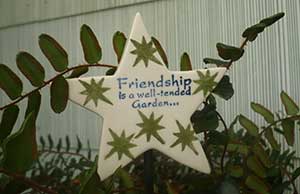 |
 |
 |
 |
 |
 |
 |
 |
 |
 |
|
Greentree Naturals Newsletter Winter 2014-2015“You are never too old to set another goal or dream a new dream.” —C.S. Lewis 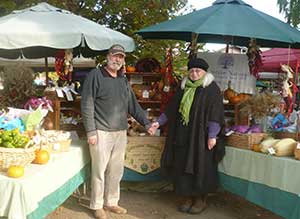
Diane & Thom at the Farmer's Market I do believe C.S. Lewis was quite right. We will spend a part of our long north Idaho winter making plans and dreaming about what we want to do next. Our dreams continue to evolve around the farm, as neither of us are too inclined to do much travel anymore. Thom & I both traveled quite a bit in our youth. We are pretty content to live out our days enjoying the fruits of our labor here on the farm. Agreed, we do need to do less physical exertion as we are getting older, but retire? Don’t you retire to do what you love? And we do love what we do. That said, we are contemplating making some changes that include shared dreams and new goals for 2015. It is an interesting time of life when you slide into being an official elder of the tribe; the tribe being your family and family of friends. We look at generation X, Y, and Z and wonder where they will go from here. We are hopeful for future generations and will continue mentoring and teaching about sustainable agriculture and organic gardening for as long as I am able. Last winter, I was involved with a series of webinars that covered an assortment of topics associated with agricultural entrepreneurship. Teaching on-line is certainly a different way to share information; I love being able to reach so many students and none of us has to leave home. This is truly a sustainable way to teach! This is the first winter in ten years that I haven’t been contracting with University of Idaho to teach. While I miss it, it allows me to get creative doing other things this winter. I worked with our local Planning and Zoning team and county commissioners with an Ag Advisory Committee to rewrite the regulations for urban Ag in our county. It took six months of meetings, reading codes, researching what other agricultural communities are doing with their urban interface, and adapting the best of what we could to make it so the regulations allowed urban farmers to raise chickens and other animals. This was an interesting process and in the end, I feel that we made positive changes and feel good to be able to give positive input as a representative of the small farm community.
The Pumpkin Project prevails and we had 42 kindergartners and first graders come out to plant pumpkins in the spring; then returned in the fall to harvest the pumpkins. We had a U-Pick pumpkin patch for 7 years, and decided just to go back to the Pumpkin Project and make it an educational opportunity with the school children. It’s always so much fun to go into the classrooms in the spring. If you are interested in more details of the Pumpkin Project, it is outlined on our website with instructions of how to do one yourself. I think any home gardener could add a pumpkin patch to include a few neighborhood children or pre-schoolers. The kids are always such a joy! This summer was year one of two on-farm research projects. The project with UI bought us a 26’x40’ high tunnel to work with. We had field data recorders set up in one of our seven hoop houses, one in the high tunnel and another set up in black plastic to compare yields along with day and nighttime temperatures. We will repeat this project two more years. We hosted a field day to share what we learned with about 40 people attending. It included a catered lunch and a great group of farmers and home gardeners. The other on-farm research project is with WSU, working with a PhD student in the Entomology Department. They took samples of beneficial insects and did soil tests at 52 different vegetable farms throughout the Pacific Northwest for comparative studies. It will be interesting to follow up with their findings comparing certified organic, “naturally grown” and conventional farms soil and the presence of beneficial insects.
Thom worked off the farm doing his tree planting inspections in the spring supervising the planting of 1.2 million trees over 4800 acres. Then he returned to the same acres in the fall to assess the survival of the trees they planted. Every year he thinks it might be his last year to do that, and then when springtime rolls around again, he is ready to go for it again. Thom bought a new used truck (1986 Ford Ranger 4x4) that will make it easier to access his woods work. Certainly not a new truck, but newer than the 1972 Ford he’s been driving! The older truck will be our farm truck for hauling hay and wood or whatever we need to haul around. One of Thom’s big projects on the farm this year, aside from setting up the new high tunnel, was building a new walk-in cooler. It is 8’x7’ and works off an air conditioner and unit called a “cool-bot.” We have been using a giant three door commercial refrigerator for the past seven years, and while it is quite large, we have outgrown it. The walk-in is an amazing addition and will improve our ability to store root crops in winter as well as have more room for more produce in summer. Thanks to Obamacare, I have health insurance for the first time in many years and was able to get my knee injury repaired this fall. I am still doing rehab but coming along nicely, and so happy to be able to walk without a limp or cane. Injuries or health issues certainly do have a way of providing perspective of how much we take for granted. We wish you peace, hope, good health & happiness in the New Year. Join us on Facebook for photos and more consistent perspective of what’s happening on the farm. ~Diane
|
2003 Rapid Lightning Road, Sandpoint, Idaho 83864 • 208-263-8957 • info@greentreenaturals.com
Site Design by Logical Expressions, Inc.


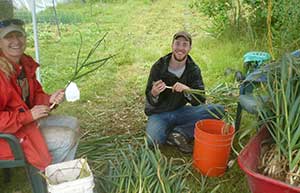 We have been farming with virtually no chemical inputs since we developed Greentree Naturals in 1990. We certified organic in 1992 and continue to support the organic program. We fertilize using manure from our chickens and a friends goats along with green manure crops. We rotate crops to help control pests, and conserve the soil using minimal tillage. We have a diversified system of growing our crops that takes better care of the environment. There is nothing easy about what we do here, but growing food, feeding our community good certified organic vegetables, and mentoring others to do the same is about as good as it gets for being satisfied at the end of each day. We are so grateful.
We have been farming with virtually no chemical inputs since we developed Greentree Naturals in 1990. We certified organic in 1992 and continue to support the organic program. We fertilize using manure from our chickens and a friends goats along with green manure crops. We rotate crops to help control pests, and conserve the soil using minimal tillage. We have a diversified system of growing our crops that takes better care of the environment. There is nothing easy about what we do here, but growing food, feeding our community good certified organic vegetables, and mentoring others to do the same is about as good as it gets for being satisfied at the end of each day. We are so grateful.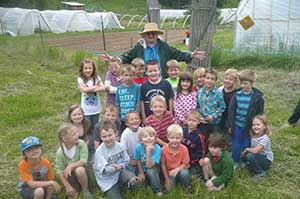 Our summer was full, as it always is: On-farm organic gardening workshops, a few land consultations, lots of family and friends visiting, ongoing CSA’s, weekly farmers market, restaurant sales, deliveries to the local natural foods store, an amazing apprentice named Linda who stuck with us from early May into late October. We also had a young man named Griffen from Colorado that lived here on the farm in one of the camp trailers for a few months, and numerous sweet volunteers to get us through the busiest times of the planting and harvest season. We get by with a little help from our friends and are so grateful for their gift of time and labor. We took our first real vacation in ten years to spend 5 days at the hot springs in Montana last November.
Our summer was full, as it always is: On-farm organic gardening workshops, a few land consultations, lots of family and friends visiting, ongoing CSA’s, weekly farmers market, restaurant sales, deliveries to the local natural foods store, an amazing apprentice named Linda who stuck with us from early May into late October. We also had a young man named Griffen from Colorado that lived here on the farm in one of the camp trailers for a few months, and numerous sweet volunteers to get us through the busiest times of the planting and harvest season. We get by with a little help from our friends and are so grateful for their gift of time and labor. We took our first real vacation in ten years to spend 5 days at the hot springs in Montana last November.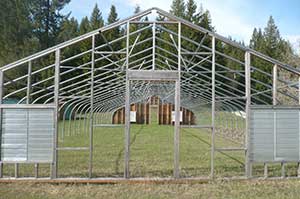 We REALLY want to get the big 96’x 30’greenhouse in operation, but want to do this sustainably. Yes, I talk about this every year and will continue until we meet this accomplishment or give up entirely. It is set up in skeleton form with the ends framed in, but sits looking rather sad. For it to go into production, we need to get power and water to it. We can dig a trench from our existing well for water, which means the cost of pipes, renting a ditcher, setting up the frost free at the greenhouse, and run a waterline across the driveway and get water there. Power is another story. Even though the power pole sits 50 feet from the greenhouse, they want $3000 just to hook up a breaker box. And all the electrical parts are more money still. This greenhouse has been a blessing and a curse. Thinking about trying to do some kind of fund raiser to make the financial support happen as farming doesn’t provide enough income to take us to that kind of expansion. Once water and power are in, we will dig a trench around the structure; bury pipes/tubes to create an earth tube system for heating and cooling the greenhouse. Next steps then to build benches, set up a germination chamber, and end up with a class room on one end for winter workshops. That said, while it would not be a tax write-off, you are welcome to make a donation towards this cause and read more about it on our website on the “donations” page.
We REALLY want to get the big 96’x 30’greenhouse in operation, but want to do this sustainably. Yes, I talk about this every year and will continue until we meet this accomplishment or give up entirely. It is set up in skeleton form with the ends framed in, but sits looking rather sad. For it to go into production, we need to get power and water to it. We can dig a trench from our existing well for water, which means the cost of pipes, renting a ditcher, setting up the frost free at the greenhouse, and run a waterline across the driveway and get water there. Power is another story. Even though the power pole sits 50 feet from the greenhouse, they want $3000 just to hook up a breaker box. And all the electrical parts are more money still. This greenhouse has been a blessing and a curse. Thinking about trying to do some kind of fund raiser to make the financial support happen as farming doesn’t provide enough income to take us to that kind of expansion. Once water and power are in, we will dig a trench around the structure; bury pipes/tubes to create an earth tube system for heating and cooling the greenhouse. Next steps then to build benches, set up a germination chamber, and end up with a class room on one end for winter workshops. That said, while it would not be a tax write-off, you are welcome to make a donation towards this cause and read more about it on our website on the “donations” page.